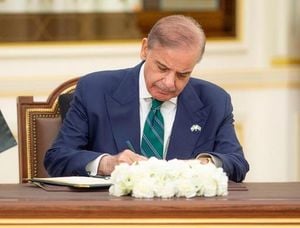Journalism, that age-old pursuit of truth and accountability, is facing one of its most perilous chapters in living memory. In the first half of 2025 alone, the landscape for reporters worldwide has darkened to levels not seen in decades, marked by escalating violence, intimidation, and an unsettling erosion of societal trust in facts. As the world marked World News Day this September, the tribulations and sacrifices of journalists—both living and recently departed—have never felt more urgent or more poignant.
According to Agence France-Presse (AFP), the first six months of 2025 saw 25 serious incidents involving its journalists, a grim tally that already surpasses the total for all of 2024. These incidents—ranging from assaults and arrests to forced expulsions and journalists fleeing for their lives—only hint at a much broader and more insidious campaign to undermine the public’s right to information. The threats are not confined to war zones or so-called unstable regimes; they are increasingly surfacing in established democracies, where traditions of press freedom once seemed unassailable.
“It is getting harder every day to do the fundamental journalistic task of collecting facts and verifying information. It is also getting much more dangerous,” wrote AFP’s Global News Director in an article commissioned for World News Day. The author described a world where the fabric of societies is being torn apart by calculated campaigns to undermine facts, with social media algorithms amplifying smears, doubts, and conspiracies. “There is no need to prove things are untrue, you only need to relentlessly smear, sow doubt and float conspiracies. Often, social media algorithms will do the rest.”
The dangers journalists face are not abstract. On August 25, 2025, five journalists were among at least 20 people killed when Israeli strikes hit Nasser hospital in Khan Yunis in the southern Gaza Strip, as reported by Gaza’s civil defence agency. The international press—including Reuters, the Associated Press, and Al Jazeera—mourned the loss of their contributors. A striking photograph from the funeral shows a colleague holding a blood-covered camera belonging to Palestinian photojournalist Hussam al-Masri, a Reuters contractor who died in the attack. The Committee to Protect Journalists has recorded nearly 200 journalist deaths in Gaza over the past two years, pointing to more than 20 incidents where individuals were believed to have been deliberately targeted.
These dangers extend far beyond conflict zones. In Buenos Aires, Argentine photojournalist Pablo Grillo was gravely injured while covering a protest against the government of President Javier Milei on March 12, 2025. Struck in the head by a police tear gas projectile, Grillo endured multiple surgeries and three harrowing months in the hospital before being discharged on June 3, 2025. According to the Argentine Journalism Forum, there were 179 assaults on media workers in 2024 alone. The presidency in Argentina even posted on social media last year: “We Do Not Hate Journalists Enough.” Such rhetoric from the highest levels of government only emboldens those who would threaten or harm reporters.
For many journalists, the very markers of their profession—press badges, flak jackets, and cameras—have become targets rather than shields. Over the past year, AFP journalists have been attacked at protests in countries as varied as Turkey, Argentina, and the United States, all while clearly identified as members of the press. The message they receive is chillingly clear: they are being targeted specifically because of their work.
In some regions, journalism is vanishing altogether. The intimidation and threats have become so severe that reporters are fleeing from the Sahel in West Africa, as well as from Central American countries like Nicaragua and El Salvador. In Eastern and Central Europe, AFP’s fact-checkers regularly receive death threats and are subjected to campaigns of intimidation. “The situation is aggravated by the rise of authoritarian practices and populist rhetoric that openly target the press,” the AFP director observed. Law enforcement’s growing impunity, bolstered by prevailing political messages, has made physical assaults on journalists all too common.
Yet, amid these dangers and the growing sense of isolation among journalists, the profession has also lost one of its titans. Veteran Middle East correspondent David Hirst died on Monday, September 22, 2025, after a battle with cancer. Hirst, who spent decades based in Beirut, was renowned for his fearless reporting and deep historical insight. He worked at The Guardian from 1963 to 1997 and contributed to the Christian Science Monitor, Middle East Eye, and Lebanon’s Daily Star. His seminal book, The Gun and the Olive Branch: The Roots of Violence in the Middle East, first published in 1977, remains a touchstone for understanding the region’s complexities.
David Hearst, current editor-in-chief at Middle East Eye, remembered Hirst as “a fearless and distinguished journalist who would be sorely missed.” He went on to praise Hirst’s groundbreaking work, including his exclusive reporting on the gassing of the Kurds in Halabja by Saddam Hussein and the destruction of Hama by Hafez al-Assad. Hirst’s willingness to speak truth to power came at great personal risk—he was kidnapped twice and banned from several Middle Eastern countries because of his reporting.
In his final column for Middle East Eye in November 2024, Hirst posed a provocative question about Israel’s actions in Gaza, referencing historian Moshe Zimmermann’s work on nations that “go mad.” Hirst wrote: “So, when all is said and done, will this Israeli madness actually turn out to have been the equal of that which brought down Hitler’s Germany, as Zimmerman suggests? Whatever does transpire, I doubt whether future historians will find cause to quarrel with him overmuch on that score.” Even at the end of his life, Hirst’s reporting refused to shy away from controversy or uncomfortable truths.
Victoria Brittain, writing in The Guardian, shared that Hirst’s one regret after his cancer diagnosis was not having enough time to finish a new edition of The Gun and the Olive Branch. It’s a telling reflection on a journalist whose life’s work was devoted to documenting, analyzing, and contextualizing some of the most turbulent events of our time.
As the digital age ushers in powerful generative AI tools, the information ecosystem is being flooded with false and fabricated content, further muddying the waters for truth-seekers. “We can all see the astonishing capacities these tools have for knowledge building and human advancement, but we are also already seeing how they can be used to pollute our information ecosystem with vast amounts of false and made-up content,” the AFP director warned. The stakes have never been higher. In a world where people talk casually about living in a post-truth era, the honest aspiration to gather information and seek the truth remains fundamental to the health of societies.
Journalism is imperfect—no one denies that. But as the dangers mount and the chorus of intimidation grows louder, the need to stand up for facts, for truth, and for those who risk everything to tell the world’s stories has never been more clear or more urgent.




